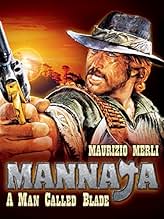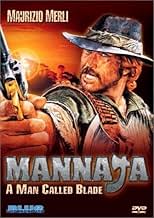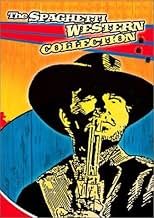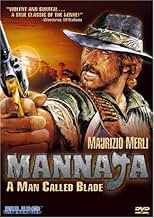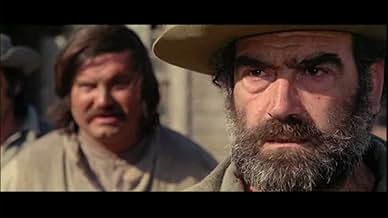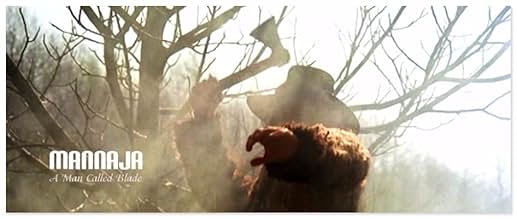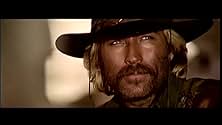CALIFICACIÓN DE IMDb
6.5/10
2.1 k
TU CALIFICACIÓN
Agrega una trama en tu idiomaA bounty hunter is hired by a mining town's crippled mayor to find his daughter, who has been kidnapped by the mayor's corrupt right-hand-man and his outlaw gang.A bounty hunter is hired by a mining town's crippled mayor to find his daughter, who has been kidnapped by the mayor's corrupt right-hand-man and his outlaw gang.A bounty hunter is hired by a mining town's crippled mayor to find his daughter, who has been kidnapped by the mayor's corrupt right-hand-man and his outlaw gang.
- Dirección
- Guionistas
- Elenco
Antonio Casale
- Dahlman
- (as Nino Casale)
Rik Battaglia
- Gerald Merton
- (as Rick Battaglia)
Vincenzo Maggio
- Oldtimer
- (as Enzo Maggio)
Sofia Lombardo
- Lucy Merton
- (as Sophia Lombardo)
Giuseppe Cardone
- Poker player
- (sin créditos)
Domenico Cianfriglia
- Valler Henchman
- (sin créditos)
Arnaldo Dell'Acqua
- Valler Henchman
- (sin créditos)
Ottaviano Dell'Acqua
- Rioting Miner
- (sin créditos)
Opiniones destacadas
I absolutely love this film.
The lead actor, Maurizio Merli, is a handsome man and a decent actor cast in the role of the "Good" Bounty Hunter, with Donald O'Brien as the "Ugly" thief/wanted man, and John Steiner as the "Bad" villain. The acting is top-notch as far as Italian Westerns go. The cinematography is beautiful, the editing great, and the direction superb. The sets are great but shrouded in a mysterious fog that lends to the movies surrealism. This film is like a very Artistic Western Graphic-Novel!
There are a few things in the plot that make you scratch your head (what movie DOESN'T suffer this problem?) but overall I would rank this in my Top Ten Westerns so far...here is the list (only culled from films I have seen thus far)
1. The Good The Bad The Ugly 2. Django 3. Mannaja 4. Fistful of Dollars 5. For a Few Dollars More 6. Tombstone 7. Outlaw Josey Wales 8. Unforgiven 9. Pale Rider 10.Silverado 11.High Plains Drifter 12.Hang Em High 13.Once Upon A Time in the West 14.Fistful of Dynamite 15.The Quick and The Dead
If you are a fan of movies that are as much art as film, then you should love Italian cinema!
The lead actor, Maurizio Merli, is a handsome man and a decent actor cast in the role of the "Good" Bounty Hunter, with Donald O'Brien as the "Ugly" thief/wanted man, and John Steiner as the "Bad" villain. The acting is top-notch as far as Italian Westerns go. The cinematography is beautiful, the editing great, and the direction superb. The sets are great but shrouded in a mysterious fog that lends to the movies surrealism. This film is like a very Artistic Western Graphic-Novel!
There are a few things in the plot that make you scratch your head (what movie DOESN'T suffer this problem?) but overall I would rank this in my Top Ten Westerns so far...here is the list (only culled from films I have seen thus far)
1. The Good The Bad The Ugly 2. Django 3. Mannaja 4. Fistful of Dollars 5. For a Few Dollars More 6. Tombstone 7. Outlaw Josey Wales 8. Unforgiven 9. Pale Rider 10.Silverado 11.High Plains Drifter 12.Hang Em High 13.Once Upon A Time in the West 14.Fistful of Dynamite 15.The Quick and The Dead
If you are a fan of movies that are as much art as film, then you should love Italian cinema!
In the early 70s, Spaghetti Westerns were going through a dry spell. Countless crappy parody films had flooded the market and strangled the life out of the genre. Then Italian crime maestro and occasional Spaghetti director Enzo G. Castellari came along and directed the psychedelic, action-packed masterpiece "Keoma". Gone was the cynicism and nihilism that seperated early Spaghettis from American Westerns. Instead there was an injection of emotion. The silent hero of the past was now a heartfelt warrior who wasn't above crying in between bouts of ass-kicking. Needless to say, it revived the genre briefly and led to a few knock-offs. "Mannaja" is probably the most obvious with it's similar visual style and music score, but Sergio Martino's keen visual sense (though not as good as Castellari's) and Maurizio Merli's excellent performance allow the film to stand on it's own two legs. There's a lot of well-staged slow motion shootouts and a fistfight in the mud here and there, along with an interesting if not compelling plotline. All in all, this is a great knock-off that has just enough originality to be a good stand-alone piece. Recommended.
Eurocrime regular Maurizio Merli headlines this Italian Western about the title bounty hunter, who wields a hatchet rather than a gun. He comes upon the town of Suttonville, which is presided over by a mining boss, McGowan (Philippe Leroy) who supposedly doesn't allow any sort of "sin" or "vice". Mannaja gets caught up in the affairs of the town, going head to head with the crooked and deadly Voller (European exploitation veteran John Steiner) and seeing to some unfinished business that he has with McGowan.
"Mannaja" is directed by Sergio Martino, who was nothing if not versatile, moving from Gialli ("Your Vice is a Locked Room and Only I Have the Key") to post-apocalypse schlock ("2019: After the Fall of New York"), to the cannibal genre ("Mountain of the Cannibal God"). Martino gives the tale some real style, beginning and ending it with very atmospheric sequences. The violence is pretty vicious, but offsetting a certain grimness is a tendency towards levity at times. A case in point: Johnny-Johnny (Salvatore Puntillo) and his dancing girls. The music further adds to the atmosphere, having been composed by Guido and Maurizio De Angelis. Martino gets down to business with an eerie succession of scenes in which outlaw Burt Craven (Donald O'Brien) is pursued by Mannaja.
The charismatic Merli, who does indeed bear a resemblance to the more famous Franco Nero, does a capable job in the lead. He's extremely well supported by Steiner, who looks right at home in this genre; Steiner is a great villain. Leroy, O'Brien, Martine Brochard as dancing girl Angela, and Sonja Jeannine as McGowan's daughter are all fine as well.
Overall, "Mannaja" is pretty good of its type, offering up nice photography, lovely ladies, decent action sequences, a few laughs, and a plot where the hero doesn't always have the upper hand.
Seven out of 10.
"Mannaja" is directed by Sergio Martino, who was nothing if not versatile, moving from Gialli ("Your Vice is a Locked Room and Only I Have the Key") to post-apocalypse schlock ("2019: After the Fall of New York"), to the cannibal genre ("Mountain of the Cannibal God"). Martino gives the tale some real style, beginning and ending it with very atmospheric sequences. The violence is pretty vicious, but offsetting a certain grimness is a tendency towards levity at times. A case in point: Johnny-Johnny (Salvatore Puntillo) and his dancing girls. The music further adds to the atmosphere, having been composed by Guido and Maurizio De Angelis. Martino gets down to business with an eerie succession of scenes in which outlaw Burt Craven (Donald O'Brien) is pursued by Mannaja.
The charismatic Merli, who does indeed bear a resemblance to the more famous Franco Nero, does a capable job in the lead. He's extremely well supported by Steiner, who looks right at home in this genre; Steiner is a great villain. Leroy, O'Brien, Martine Brochard as dancing girl Angela, and Sonja Jeannine as McGowan's daughter are all fine as well.
Overall, "Mannaja" is pretty good of its type, offering up nice photography, lovely ladies, decent action sequences, a few laughs, and a plot where the hero doesn't always have the upper hand.
Seven out of 10.
By 1977, the spaghetti western was already on its death throes and if I'm not horribly mistaken, Mannaja is the last major release in the genre. These latter day spaghetti westerns are all visibly different from the 67-71 ones in that they tried to push the envelope in different ways. Ironically the vast amount of tired, quickie Django and Sartana clones that sprung in the late 60's weren't the final nail in the coffin. It seems that after westerns like Mannaja the genre had nowhere to go, having explored every nook and cranny of the old west and milked every bit of potential in the process.
Sergio Martino was not a regular spaghetti western director. He made his name through a series of fantastic giallo thrillers in the early 70's (All the Colours of the Dark, The Strange Vice of Mrs. Wardh etc) but he was generally a genre director who dabbled with anything that came his way. As a testament to his talent, he was usually successful, often with stunning results. He had tried his hand on the western once more in the Anthonio De Steffen vehicle Arizona Colt Returns, which was a pleasurable entry but business as usual for the most part. Mannaja is markedly different in that it strives for more. It has ambition and the means to pull it off.
Strangely, Mannaja takes its cue from Enzo G. Castellari's incredible Keoma (or as it was retitled for commercial purposes, Django Rides Again) from one year earlier. Maurizio Merli's Mannaja bears more than a passing resemblance to the dirty and grim looking Keoma played by Franco Nero, there are several beautiful slo-mo shots, a dream-like atmosphere in places, it's quite brutal (a hand is chopped, a woman is whipped, a man gets an axe in his head, old ladies and other innocent bystanders are shot and killed) and the score is very weird by spaghetti western standards and it can be as annoying as Keoma's (although I didn't mind the latter). Just as Keoma, it doesn't shy away from taking risks and luckily it pays off, no least thanks to Martino's skillful directing. There's visual awesomeness to be found throughout the movie. Striking compositions are enhanced by great set design lending a gritty feeling to everything from the dilapidated town to the dirty clothes to the muddy streets. Nature plays a big part in how the movie looks: rain, mud, fog are all used to great effect, the last shootout in the fog adding a surreal, ghost-town quality to it. The look of the first half hour reminded me of Altman's McCabe and Mrs. Miller for some reason, with a dash of Django. It also appears to be very much influenced by the work of Sam Peckinpah, whom Sergio Martino himself cites as an inspiration. Generally it's equal parts gritty and atmospheric and with enough budget to hold everything on the seams.
Maurizio Merli made his name in the Italian movie business by playing violent Dirty Harry-esquire cops in polizioto crime flicks and was quite successful as a genre actor. He can play the mean machine effortlessly and it's a real pleasure to watch him as a badass bounty hunter here. A real shame that he didn't do more westerns and even more so that he passed away 4-5 years after making this one. The rest of the cast all turn in fine performances.
Mannaja might have come during the twilight of the spaghetti western but it's easily one of the best it has to offer. A must-see for fans.
Sergio Martino was not a regular spaghetti western director. He made his name through a series of fantastic giallo thrillers in the early 70's (All the Colours of the Dark, The Strange Vice of Mrs. Wardh etc) but he was generally a genre director who dabbled with anything that came his way. As a testament to his talent, he was usually successful, often with stunning results. He had tried his hand on the western once more in the Anthonio De Steffen vehicle Arizona Colt Returns, which was a pleasurable entry but business as usual for the most part. Mannaja is markedly different in that it strives for more. It has ambition and the means to pull it off.
Strangely, Mannaja takes its cue from Enzo G. Castellari's incredible Keoma (or as it was retitled for commercial purposes, Django Rides Again) from one year earlier. Maurizio Merli's Mannaja bears more than a passing resemblance to the dirty and grim looking Keoma played by Franco Nero, there are several beautiful slo-mo shots, a dream-like atmosphere in places, it's quite brutal (a hand is chopped, a woman is whipped, a man gets an axe in his head, old ladies and other innocent bystanders are shot and killed) and the score is very weird by spaghetti western standards and it can be as annoying as Keoma's (although I didn't mind the latter). Just as Keoma, it doesn't shy away from taking risks and luckily it pays off, no least thanks to Martino's skillful directing. There's visual awesomeness to be found throughout the movie. Striking compositions are enhanced by great set design lending a gritty feeling to everything from the dilapidated town to the dirty clothes to the muddy streets. Nature plays a big part in how the movie looks: rain, mud, fog are all used to great effect, the last shootout in the fog adding a surreal, ghost-town quality to it. The look of the first half hour reminded me of Altman's McCabe and Mrs. Miller for some reason, with a dash of Django. It also appears to be very much influenced by the work of Sam Peckinpah, whom Sergio Martino himself cites as an inspiration. Generally it's equal parts gritty and atmospheric and with enough budget to hold everything on the seams.
Maurizio Merli made his name in the Italian movie business by playing violent Dirty Harry-esquire cops in polizioto crime flicks and was quite successful as a genre actor. He can play the mean machine effortlessly and it's a real pleasure to watch him as a badass bounty hunter here. A real shame that he didn't do more westerns and even more so that he passed away 4-5 years after making this one. The rest of the cast all turn in fine performances.
Mannaja might have come during the twilight of the spaghetti western but it's easily one of the best it has to offer. A must-see for fans.
The titular character thankfully isn't an ancestor of overrated vampire-hunter Wesley Snipes, but a genuinely old-fashioned and testosterone-laden spaghetti western hero who furiously wanders around the deserts like a one-man-army, hunting down wanted criminals for the rewards on their head. Blade is relentless but fair, he has an imposing charisma and wields hatchets as professionally as he fires shotguns. In short, he's the ideal guy to dedicate another magnificently violent, imaginative and nasty euro-Western to! And, oh yes, Sergio Martino's film can easily compete with the absolute greatest efforts in this sadly extinct sub genre of cult cinema, like Sergio Corbucci's "Django", Sergio Sollima's "The Big Gundown" and perhaps even some of Serio Leoni's lesser known movies. "A Man Called Blade" is a very eventful and exciting film, chock-full of outrageous gun & fistfights, mean & treasonous bandits and wild ambushes. When arriving in the little town of Suttonville to claim the reward on a killer's head, Blade encounters the vicious & corrupt sidekick of a prominent businessman. Blade offers his services to McGowan and Voller, because despite exploiting the local miners, large troops of outlaws continuously steal the silver. Voller wants to get rid of Blade as soon as possible, because he plots to take over the empire, but Blade is tough and has an extra personal score to settle with McGowan. The plot twists perhaps aren't the most original ones ever, but bear in mind "A Man Called Blade" got released during the dying years of spaghetti western cinema. And even though not always original, Martino's film is fast-paced and doesn't feature a single dull moment. The fights are dirty (literally) and the violence is rather graphic, with several cowboys dying from hatches in their foreheads or bullets between the eyes. The outdoor locations are sublime and I absolutely loved the moody theme song that gets repeated during the film's most essential sequences. Other fans seem to disapprove of the music in this film, but I thought it was excellent. Maurizio Merli makes a terrific macho hero. Perhaps not as legendary as Franco Nero or Tomas Milian, but close enough. The film sadly doesn't have a strong female lead, only a sympathetic go-go dancer and the silent daughter of the mayor. The most memorable performance is given by John Steiner as Blade's sadistic opponent Voller. With his ugly face and almost natural aura of arrogance, Steiner gave image of multiple villains in Italian cult films. His role here definitely ranks among the best! Highly recommended.
¿Sabías que…?
- TriviaThe reason the exteriors have so much fog and smoke was because the filmmakers were trying to hide the fact that the studio, Elios Studio near Rome, needed to be renovated.
- ErroresIn the opening sequence the man captured screams and you can clearly see his modern fillings.
- Versiones alternativasUK versions are cut by 6 secs by the BBFC to remove footage of horsefalls.
- ConexionesFeatured in The Spaghetti West (2005)
Selecciones populares
Inicia sesión para calificar y agrega a la lista de videos para obtener recomendaciones personalizadas
Detalles
- Fecha de lanzamiento
- País de origen
- Idioma
- También se conoce como
- A Man Called Blade
- Locaciones de filmación
- Campo Imperatore, L'Aquila, Abruzzo, Italia(Stagecoach / Horse Riding Scenes)
- Productoras
- Ver más créditos de la compañía en IMDbPro
- Tiempo de ejecución1 hora 41 minutos
- Mezcla de sonido
- Relación de aspecto
- 2.35 : 1
Contribuir a esta página
Sugiere una edición o agrega el contenido que falta

Principales brechas de datos
By what name was Mannaja (1977) officially released in India in English?
Responda
